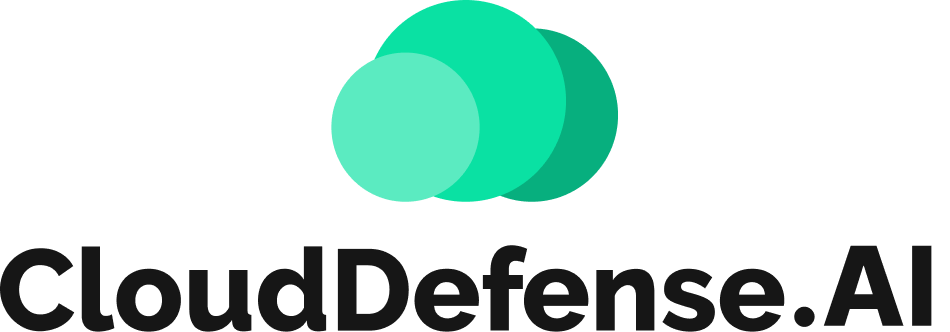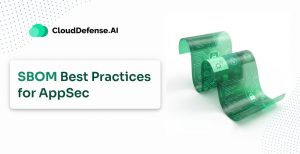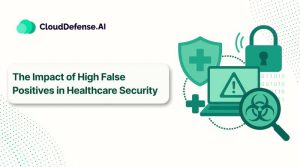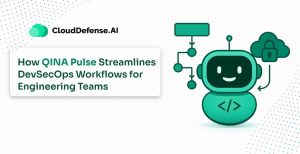The cloud-native application protection platform, or CNAPP, has revolutionized how developers and AppSec teams secure modern cloud-native applications. It has brought a major shift to the security aspect of cloud native applications.
With containers and Kubernetes becoming a default for development and a high-speed dev cycle emerging as a necessity, traditional security models are becoming incapable. As cloud native application adoption increases, the complexity associated with increasing alerts and security tools also grows.
CNAPP provides a comprehensive solution as it consolidates all the siloed security tools into a unified platform that secures applications from code to cloud. Here is a complete guide to cloud native application security for DevSecOps and how CNAPP aids Dev and AppSec.
The Systematic Shift to Cloud-Native Application
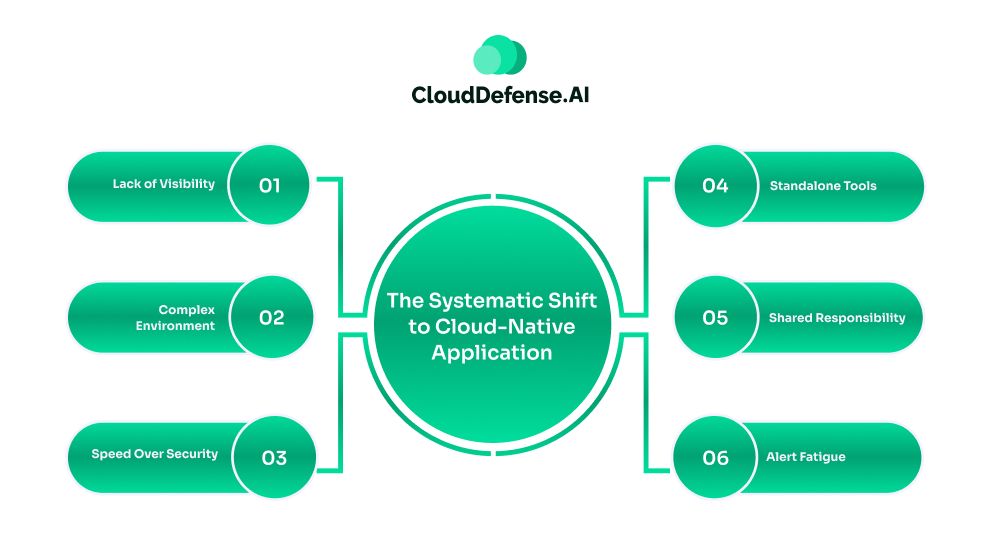
Modern application development has shifted to a cloud native approach. Developers are leveraging cloud native platforms that are based on microservices, containers (Docker), serverless functions, and orchestrators(Kubernetes).
As a result, organizations are able to achieve faster development, optimum resilience, and scalability. Cloud resources are always evolving and changing, requiring organisations to bring a new approach that offers proactive cloud security. However, this shift to a cloud environment also introduces many challenges:
- Lack of Visibility: Even though organizations have shifted to cloud-native applications, many of them still rely on traditional security approaches. Since these applications are built on numerous containers, open-source components, and microservices, they provide limited visibility into all assets.
- Complex Environment: A cloud native application development environment involves multiple cloud providers, Docker, Kubernetes clusters, and microservices. Managing and maintaining optimum security across every aspect is highly complex.
- Speed Over Security: Developers nowadays are always pushing for high-speed development through DevOps and CI/CD pipelines. It not only makes the security efforts outpace but also often causes vulnerabilities to be overlooked. Thus, a lot of security threats make their way into the deployment environment.
- Standalone Tools: A lot of teams rely on standalone tools for different security tasks, which leads to visibility gaps. A team might utilize one tool for cloud application security while another tool for container security, causing context switching for threat information.
- Shared Responsibility: With cloud native applications, both cloud providers and organizations are responsible for the security. While the cloud providers are responsible for taking care of the cloud infrastructure, organizations have to safeguard the application and configuration. A fault at any side, especially misconfiguration, leads to a cyberattack.
- Alert Fatigue: The use of siloed and traditional tools lacking contextual information often creates a lot of security alerts containing false positives. The lack of prioritized alerts without context forces the development and AppSec team to assess all the alerts, leading to alert fatigue.
To overcome these issues, CNAPP has emerged as the best possible solution for offering code-to-cloud security. It serves as a holistic solution offering comprehensive cloud native application security with a shift-left approach.
What is CNAPP?

A cloud native application protection platform(CNAPP) is a unified platform offering complete cloud native application security. It consolidates multiple security tools and functionalities into one platform, providing a holistic security solution. It combines key cloud security technologies, which include CSPM, CWPP, IAC security, CIEM, and others.
It provides complete visibility through a single pane, enabling dev and AppSec teams to collaborate, manage posture, and address security risks. According to Gartner, CNAPP serves as the ideal solution to unify security and compliance capabilities to address cyber threats in the cloud-native application lifecycle.
CNAPPs continuously monitor all operations by integrating security checks into every check. It also promotes DevSecOps through a collaborative work culture to provide a comprehensive runtime and code security. Some of the key benefits it has on offer are:
- Simplifies cloud-native application security: CNAPP by integrating multiple cloud-native security tools in a single platform simplifies the job of Dev and AppSec teams. It simplifies all the processes and provides complete visibility.
- Unified Risk Assessment: CNAPP, through a single enables teams to cover all types of cyber threats- vulnerabilities, misconfiguration, hardcoded secrets, etc, across the multi-cloud environment. The integration of AI enables the platform to correlate all the risks and prioritise alerts.
- Identifies Zero-Day Threats: A key benefit is that it empowers teams with advanced threat detection capability. As a result, it is able to identify unknown vulnerabilities , lateral movements, and novel attacks.
- Low Operation Cost: In comparison to other cloud native application security tools, CNAPP has a lower operation cost. It reduces the need to maintain multiple and redundant security tools. It also doesn’t require the integration of multiple agents that are often rejected by DevOps teams.
- Contextualized Detection and Response: Modern CNAPPs enable teams to identify and remove attack paths by employing contextual risk assessment. It also holds the capabilities to identify threats and automate responses in real time.
Core CNAPP Components Empowering Dev and AppSec
CNAPP combines multiple security capabilities to provide comprehensive cloud native application security for Dev and AppSec:
- Cloud Security Posture Management(CSPM)- CSPM is a security process that continuously monitors, detects, and remediates excessive permissions and compliance violations. It acts as a security guardrail for SaaS, PaaS, and IaaS environments and automates the process to remediate all the misconfiguration issues. Modern organization utilizes CPSM to manage and secure multi-cloud and public cloud environments.
- Cloud Workload Protection Platform(CWPP)- CWPP is an advanced cybersecurity solution that offers comprehensive and continuous protection to VMs, containers, workloads, and serverless functions. It provides organizations with a set of security controls to safeguard the integrity and availability of the workloads. It is highly efficient in offering runtime protection, vulnerability scanning, and detection and remediation of malware in real-time.
- Cloud Infrastructure Entitlement Management(CIEM)- CIEM is an automated cloud security solution that manages all the identities and privileges in the cloud environment. It prevents excessive permissions to mitigate various types of security threats. Importantly, CIEM enables organizations to implement the principle of least privilege access to all the resources and infrastructure in the cloud, reducing the attack surface.
- Kubernetes Security Posture Management(KSPM)- Modern CNAPP solutions integrate KSPM to help organizations automatically detect and fix vulnerabilities in Kubernetes. Modern applications are built on Kubernetes, and KSPM provides complete visibility and security controls to maintain security posture. It is highly effective in detecting Kubernetes misconfiguration and automating scans across clusters.
- Infrastructure-as-Code Scanning(IaC)- IaC scanning is the process of assessing code that is used in the infrastructure and configuration. It also analyzes all the scripts that provision and configurations to identify any violations, misconfigurations, and compliance issues. IaC primarily focuses on finding issues with the application code as it determines the security of the cloud operation. It complies with the shift-left approach by scanning IaC templates early for IaC security and preventing vulnerabilities from reaching the deployment stage.
- Data Security Posture Management(DSPM)- DSPM is a comprehensive security technology that aims to safeguard all sensitive data across the multi-cloud environment. It assesses the vulnerability state of all the data and safeguards it from unauthorized access, risk to regulatory issues, alteration, and leakage. DSPM protects by continuously monitoring the data and automating remediation efforts when a sudden data exposure occurs.
The combination of core cloud security technologies enables organizations to assess risk posture across cloud environments and ensure optimum cloud-native application security. CNAPP, by integrating security checks through these key components, covers every aspect of the cloud environment. It introduces security controls at the earliest stage of the development environment, helping implement a shift-left security culture.
How CNAPP Benefits Dev and AppSec Teams
CNAPP not only unifies key security technologies but also bridges the gap between the development and application security teams. It fosters a security-first culture by “shifting left” application security from the final step in the dev cycle to an integrated and continuous process. Although the end goal is to provide optimum cloud-native application security, CNAPP benefits dev and AppSec teams in different ways.
CNAPP for Developers
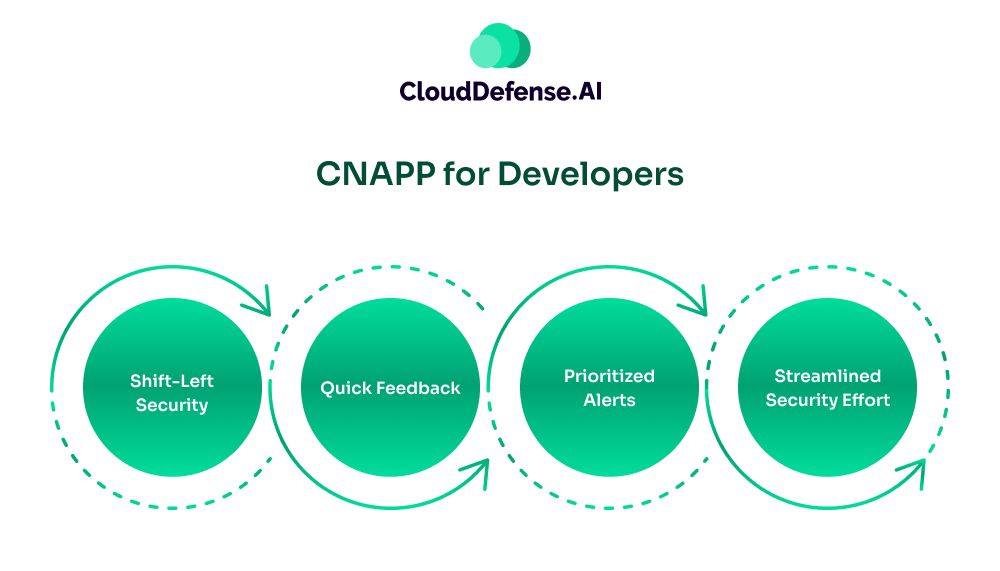
CNAPP streamlines all the security efforts for the development team while they code, empowering them to ensure optimum code security. It benefits them by:
- Shift-Left Security: CNAPP enables developers to maintain cloud native application security policies by scanning code repositories, container images, and other dependencies for vulnerabilities. Availability of security tools like AI-SPM and CSPM enables developers to identify and remediate security issues at the earliest. Ultimately, it helps the organization to achieve an optimum security posture across cloud environments.
- Quick Feedback: All the cloud-native security tools are integrated early in the CI/CD pipeline, offering quick feedback regarding vulnerabilities. The information is fed directly into Jira or Slack, which allows developers to understand whether the code is flawed or not.
- Prioritized Alerts: CNAPP provides developers with prioritised security alerts, negating high false positives. It provides security alerts with contextual information, which is useful for developers as they can fix issues that have the maximum impact on security. Importantly, it prevents them from switching tools to know about the security alerts and helps in saving their crucial development time.
- Streamlined Security Effort: CNAPP streamlines all the security efforts for the development team. The integrated platform enables development teams to easily manage multiple security tools without getting bottlenecked. Many AI-based security technology also helps devs to fix vulnerabilities through automated remediation processes containing clear instructions.
CNAPP for Application Security Teams
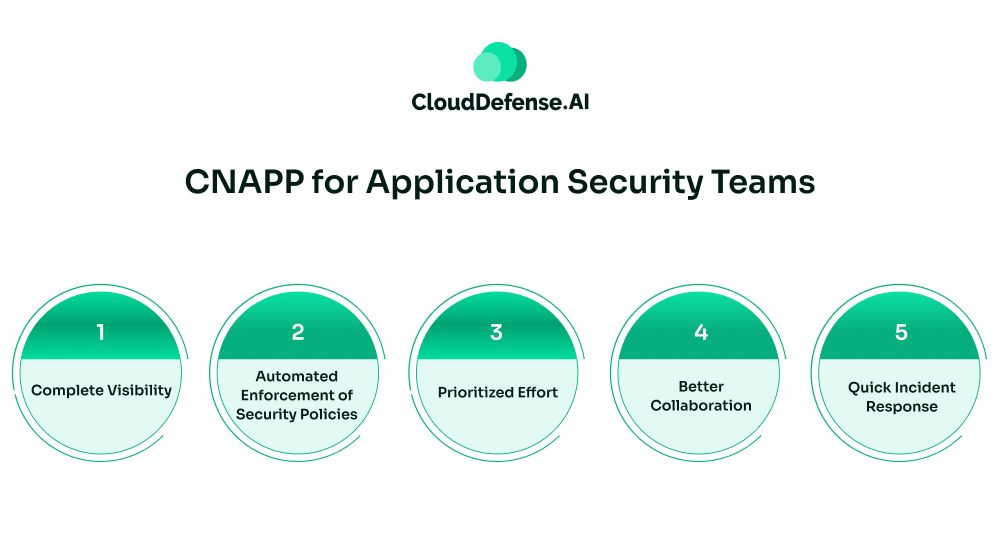
CNAPP empowers the AppSec team with comprehensive security controls and visibility to manage vulnerabilities in the multi-cloud environment. It helps them make proactive security efforts to establish robust cloud-native application security. It provides them:
- Complete Visibility: CNAPP, through its unified platform, enables the AppSec team to have a centralized view of security posture across the entire cloud-native stack. As a result, it helps the team to eliminate all blind spots and identify threats like misconfigurations and runtime threats.
- Automated Enforcement of Security Policies: Another huge benefit to the AppSec team is that they can utilize CNAPP to enforce security policies and guardrails. AppSec can define policies and enforce them as security policy-as-code. CNAPP automatically monitors all policy enforcement and remediates any violations to ensure consistency.
- Prioritized Effort: Modern CNAPP solutions are assisted by artificial intelligence, which provides contextual information and prioritized alerts when a vulnerability is detected. By correlating information from different sources it provides a complete visual of the attack path in real-time, enabling teams to remediate issues that have the most impact.
- Better Collaboration: CNAPP, through its unified platform, provides a common ground for all the security data, processes, and workflows. It enables the development and AppSec team to share information and work collaboratively for cloud-native application security efforts.
- Quick Incident Response: Through continuous monitoring and detection capabilities, CNAPP quickly sends alerts to the team. It shows the attack path or a particular line of code where a vulnerability is detected. Moreover, all the information is shared in the centralised dashboard. This enables all the AppSec to work together to investigate and remediate the issue quickly.
Bottom Line
In today’s fast-paced cloud-native development workflow, siloed security tools are no longer effective for cloud-native application security. CNAPP enables organizations to go beyond a siloed approach and provides a reactive and unified approach to application security. It integrates multiple core cloud-native security capabilities into one platform and offers a centralised visibility from code-to-cloud.
CNAPP empowers organizations to deploy cloud-native applications at the speed of DevOps while maintaining optimum cloud-native application security. It not only automates the shift-left approach but also streamlines the security efforts for dev and AppSec teams in the multi-cloud environment.
